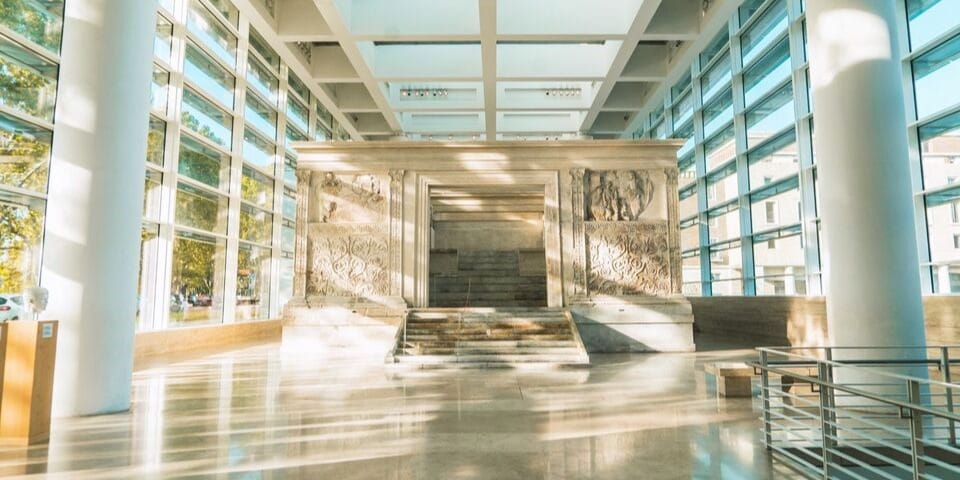

24710 views

| Tickets |
Buy tickets online: |
|---|---|
| Tip | Inside, focus on the intricate reliefs, particularly the procession of the imperial family and the detailed floral motifs. You can use the multimedia guides to deepen your understanding. Don't miss the altar's inscriptions, which are rich with historical significance. |
| Opening Hours |
Sunday:
-
Monday:
-
Tuesday:
-
Wednesday:
-
Thursday:
-
Friday:
-
Saturday:
-
|
| Recommended tour | |
| Closest bus stops |
|
| Closest subway stations |
|
| Address | Lungotevere in Augusta, Roma |
| Website | www.arapacis.it |
The Ara Pacis Museum (ital. Museo dell’Ara Pacis) belongs to the museum system run by Rome City Council; it is in the Ara Pacis of Augustus (Ara Pacis Augustae), an ancient monument originally unveiled on January 30, 9 BC.
Contents
ToggleIn 13 BC, the Roman Senate decided to erect an altar in honor of Emperor Augustus. Four years later, in the year 9 AC, the Ara Pacis Augustae, or Augustus’ Altar of Peace, was dedicated. A magnificent monument that honors the peace and prosperity that Emperor Caesar Augustus brought to Rome.
This marble monument honors the peace that the emperor brought to the Mediterranean after his successful campaigns in Hispania and Gaul. It was situated in Campo Marzio, a large territory outside the city limits that served as the northern gateway to Rome via the Via Flaminia, now Via del Corso. When the legions returned from a battle, they practiced purification rituals here.
Subsequently, the structure vanished by the beginning of the second century AD. The monument was eventually covered in Tiber River mud, and the area’s urbanization resulted in the loss of the site. In the 20th century, this historical site was moved from Campo Marzio to the Tiber Bank and set up in front of the Augustus Mausoleum, where it is now. It was recovered from a Renaissance building’s foundation.
As a temple where only priests and vestals participated in the sacrifice of sacred animals, the Ara Pacis is one of the most important structures from Ancient Rome.
Interestingly, the Ara Pacis monument is an altar housed inside a closed Carrara marble construction. Its remarkable decoration includes several reliefs depicting the Augustan family in procession. In addition, there are several allegories about the founding of Rome.
The museum of the Ara Pacis is the first significant architectural and urban intervention in Rome’s historic center since Fascism. American architect Richard Meier created it, which is made of steel, travertine, glass, and plaster. This triumphal-style structure references ancient Rome.
Undoubtedly, the white color highlights the style of Richard Meier’s work. Moreover, the travertine slabs adorning part of the building reflect design changes (aluminum surfaces were initially planned) that were made after the design review to account for the controversy that sparked nostalgia for the previous pavilion built on the same site in 1938 by the architect Vittorio Ballio Morpurgo.
The structure of the Museum of the Ara Pacis has generated debate. Vittorio Sgarbi, a noted art critic and controversialist, described it as “a Texas gas station on the very ground of one of the most important urban centers in the world” and the first step towards the “internationalization” of Rome. The New York Times considered it a failure. However, there are different viewpoints; for instance, Achille Bonito Oliva admired Meyer’s design.
Have a pleasant visit to the Museum of the Ara Pacis!
Author: Kate Zusmann
This website uses cookies. For more info read the cookies policy
Rome.us © 2025. Created with love by Roman experts and guides.